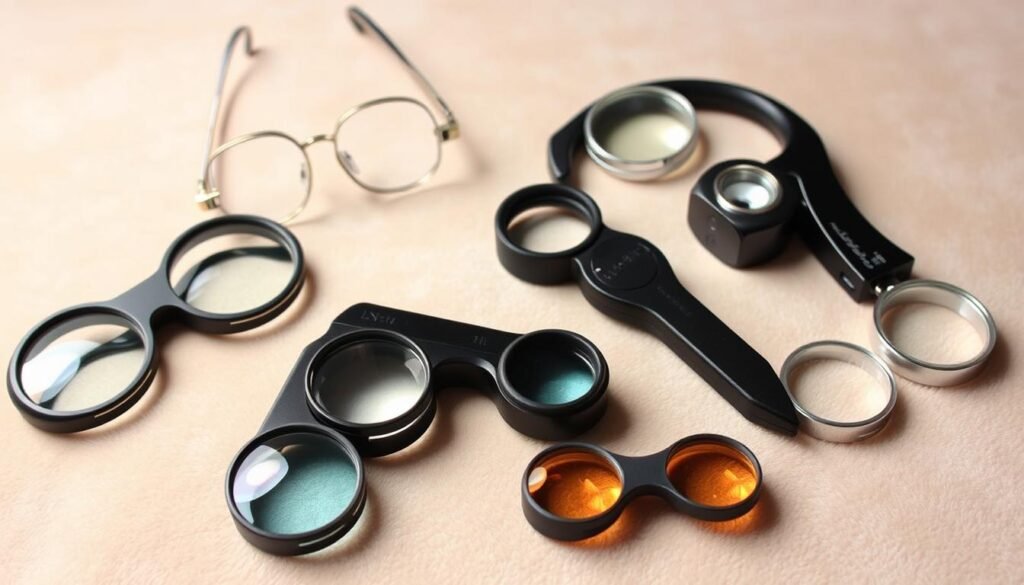A jewelers loupe is a must-have for gem lovers and gemologists. This small magnifying glass helps examine gemstones, minerals, and jewelry up close. It reveals tiny details, inclusions, and helps assess gem quality.
Using a loupe can boost your understanding of gemology. It’s great for both experienced collectors and beginners. With practice, you’ll uncover the hidden beauty of precious stones.
Table of Contents
ToggleKey Takeaways
- Jewelers loupes are essential tools for gemologists and gem enthusiasts
- Loupes offer the ability to closely examine gemstones, minerals, and jewelry
- A jewelers loupe allows users to observe intricate details, identify inclusions, and assess quality
- Mastering the use of a jewelers loupe can enhance appreciation and understanding of gemology
- Jewelers loupes are available in a range of magnification levels and lens configurations
What is a Jewelers Loupe?
Definition and Purpose
A jewelers loupe is a vital optical tool for gem experts and jewelry professionals. It magnifies objects for close examination. This tool allows for detailed inspection of gemstones, minerals, and other gem materials.
Jewelers loupes are available in various magnification levels and sizes. They serve specific purposes in the jewelry and gemology industries. These tools help users examine the details, inclusions, and characteristics of gems and precious metals.
Accurate identification, grading, and value determination rely on this detailed observation. The jewelers loupe is indispensable for gemologists and jewelry professionals alike.
- The jewelers loupe is a must-have gemologist tool for inspecting jewelry and gemstones.
- It allows for close-up, detailed examination of the external and internal features of gems and precious metals.
- Jewelers loupes come in a range of magnification levels and lens configurations to suit different needs.
- These magnifying glasses play a crucial role in gem identification, evaluation, and quality assessment.
“The jewelers loupe is often referred to as a gemologist’s best friend, as it allows for detailed observation and examination that is crucial for gem identification and evaluation.”
Types of Jewelers Loupes
Jewelers loupes offer various magnifications and lens configurations. The most common is 10x, balancing magnification and depth of field. Higher magnifications like 20x can be trickier to use.
Loupes can have single, doublet, or triplet lens designs. Triplet lenses provide the best image quality and reduced distortion.
Magnification Levels
- 10x magnification: Provides a good balance of magnification and depth of field for most gemstone observations.
- 20x magnification: Offers higher magnification but with a reduced depth of field, making it more challenging to use.
- 3x magnification: Enables objects to appear thrice their actual size when viewed.
Number of Lenses
- Single lens loupe: Has limited magnification capabilities.
- Doublet loupe: Offers improved image quality compared to a single lens.
- Triplet loupe: Provides the best image quality and reduced distortion, making it the preferred choice for gemologists and jewelers.
| Loupe Type | Magnification | Image Quality | Depth of Field |
|---|---|---|---|
| Single Lens | 3x | Limited | Moderate |
| Doublet | 10x | Improved | Moderate |
| Triplet | 10x | Best | Good |
Choosing a loupe depends on your preferences and gemological needs. For gemology and jewelry examination, 10x triplet loupes are ideal.

How to Use a Jewelers Loupe
Using a jeweler’s loupe requires practice, but becomes easy with time. Place the loupe in front of your dominant eye. Hold the gem in your other hand and adjust the distance for focus.
Keep both eyes open to avoid strain. Try different lighting angles to see the gem’s features clearly. This helps you use the jewelry magnifier to spot important details in precious stones.
- Position the loupe in front of your dominant eye.
- Hold the gem or specimen in your other hand.
- Adjust the distance until the object comes into sharp focus.
- Keep both eyes open to reduce eye strain.
- Experiment with different lighting angles to observe the gem’s features.
Learning to use a jeweler’s loupe is key for gemologist tools fans. With practice, you’ll spot tiny details that affect a gemstone’s quality and value.
| Magnification Level | Recommended Use |
|---|---|
| 2x to 5x | Viewing larger gems and jewelry pieces |
| 10x | The industry standard for diamond and gemstone inspection |
| 20x to 30x | Identifying finer details and inclusions |
Consistency is crucial when using a jeweler’s loupe. Keep the viewing distance and angle steady for accurate gem assessments. Practice these techniques to become a gem inspection pro.
“A 10x triple-tin magnifying lens is commonly used for viewing diamond and other gemstone grades.”

Examining Gemstones with a Jewelers Loupe
A jewelers loupe is vital for evaluating gemstones’ intricate details. It helps assess craftsmanship by examining exterior features like polish and facet meets. The loupe also reveals internal features crucial for gem identification and authentication.
Exterior Features
Gemologists use loupes to inspect a gemstone’s surface quality. They evaluate polish, facet precision, and girdle condition. These factors reveal the gem cutter’s skill and impact the stone’s appeal and value.
Inclusions and Internal Features
Loupes uncover hidden inclusions and internal features of gemstones. These serve as a gem’s unique fingerprint, aiding identification. Examining inclusion types and distribution helps determine a gem’s origin and quality.
Loupe mastery is crucial for gemologists and enthusiasts alike. It offers deeper insights into gemstones’ intricate world. This tool unlocks a comprehensive appreciation of these natural marvels.
| Feature | Description |
|---|---|
| Exterior Features | Polish, facet meets, girdle condition |
| Inclusions and Internal Features | Type, size, distribution of inclusions |
“The jewelers loupe is the gemologist’s best friend, unlocking the hidden secrets and intricate details of these natural wonders.”
Jewelers Loupe for Cabochons
A jewelers loupe is vital for examining cabochon-cut gemstones. This tool helps assess the polish quality and curvature evenness of domed gems. With a loupe, gemologists can spot imperfections that affect a gem’s appearance and value.
Close-up gem observation is key for gemstone identification and verifying authenticity. The 10X loupe is ideal, offering balanced magnification and field depth. Higher magnification loupes can be tricky to use on cabochons.
“Gemologists consider the 10X loupe as the standard for hand-held gem identification with ten-power magnification.”
Studying a cabochon’s exterior and internal features helps assess quality, origin, and value. This analysis is crucial for gemstone identification. It helps buyers and collectors make smart choices.
Learning to use a jewelers loupe for cabochons is a must-have skill. It opens up a new world of gemstone beauty. You’ll gain a deeper appreciation for these fascinating stones.
The History of the Jewelers Loupe
The jewelers loupe has a rich history spanning thousands of years. Its origins trace back to ancient Egypt and Mesopotamia. Early lenses were used as far back as 2500 B.C.E.
The Middle Ages and Renaissance saw the development of spectacles and telescopes. These innovations laid the groundwork for the modern jewelers loupe. In 1876, a German doctor created the first “loupe” resembling today’s design.
Initially a surgical tool, the loupe quickly found its way into gemology. It became essential for examining and identifying precious stones. Since then, the loupe has evolved with advancements in lens technology.
From single-lens magnifiers to sophisticated triplet loupes, these tools are vital in the jewelry industry. The loupe’s history reflects our desire to understand the natural world. It helps us explore both vast cosmos and tiny gem details.
“The jewelers loupe is not just a tool, but a window into the hidden wonders of the gemstone world.”
Today, the loupe remains crucial for gemologists, jewelers, and enthusiasts. It allows them to explore intricate details of precious stones. The loupe’s history showcases human ingenuity and our drive to uncover nature’s secrets.
Where to Buy a Jewelers Loupe
Jewelers loupes are vital tools for gem lovers. Online stores like JTV offer many affordable options. They have various magnification levels and styles for beginners and experts alike.
For high-end loupes, check out the Gemological Institute of America (GIA). The Gemological Association of Great Britain (Gem-A) is another great resource. These institutions may sell loupes or suggest where to find them.
When choosing a jewelers loupe, keep these features in mind:
- Magnification Power: Loupes usually range from 10x to 30x magnification. 10x is most common. Higher power shows more detail but can be harder to use.
- Number of Lenses: “Triplet” loupes have multiple lenses. They offer better color and reflection views for accurate gem inspection.
- Lighting: Some loupes have LED lights. These enhance clarity during examinations, especially when checking diamonds for fluorescence.
A quality jewelers loupe is a must-have for any gem enthusiast. It helps you see the hidden beauty in your favorite gemstones.
Conclusion
The jewelers loupe is a crucial tool for gem enthusiasts and gemologists. It allows for close examination of precious stones and jewelry. This tool helps users gain a deeper understanding of gemstones’ intricate details and characteristics.
A high-quality jewelers loupe can enhance your gem exploration experience. It offers magnification levels from 2x to 30x. Triplet lenses provide the clearest vision for detailed inspections.
The loupe is essential for gemologists, watchmakers, and photographers. It reveals hidden wonders and subtle nuances in each gemstone. This knowledge can improve your personal enjoyment and inform purchasing decisions.
FAQ
What is a jewelers loupe?
A jewelers loupe is a vital tool for gem lovers and experts. It’s a small magnifying glass that reveals tiny details in gemstones and jewelry. This compact device helps assess the quality of precious stones.
How does a jewelers loupe work?
A jewelers loupe magnifies objects for closer inspection. It allows users to examine the features of gemstones and minerals in detail. Experts use it to study both external and internal aspects of gem materials.
What are the different types of jewelers loupes?
Jewelers loupes come in various magnifications and lens designs. The most common is 10x, offering a good balance of zoom and depth. Higher magnifications like 20x can be trickier to use.
Loupes can have single, doublet, or triplet lenses. Triplet designs provide the best image quality with less distortion.
How do you use a jewelers loupe effectively?
Using a jewelers loupe takes practice but becomes natural quickly. Place the loupe in front of your dominant eye. Hold the gem in your other hand.
Adjust the distance until the object is in sharp focus. Keep both eyes open to reduce strain. Try different lighting angles to see all features clearly.
How can a jewelers loupe be used to examine gemstones?
A jewelers loupe is crucial for assessing gemstone quality. It reveals details about cutting craftsmanship, polish, and facet meets. The loupe also shows inclusions and internal features, helping with identification and authenticity checks.
How can a jewelers loupe be used to examine cabochon-cut gemstones?
Loupes are great for studying cabochon-cut gems with domed, polished surfaces. They help assess polish quality and curvature evenness. Experts can spot flaws affecting the gem’s look and value by observing light reflections.
What is the history of the jewelers loupe?
Early lenses date back to 2500 B.C.E. in ancient Egypt and Mesopotamia. The modern loupe evolved from spectacles and telescopes developed during the Middle Ages.
A German doctor created the first “loupe” in 1876 as a surgical tool. This inspired its use in gemology and medicine.
Where can I purchase a jewelers loupe?
You can buy jewelers loupes from online shops, jewelry supply stores, and gemological organizations. JTV offers affordable loupes in various magnifications and styles. For specialized loupes, check with GIA or Gem-A for recommendations.

